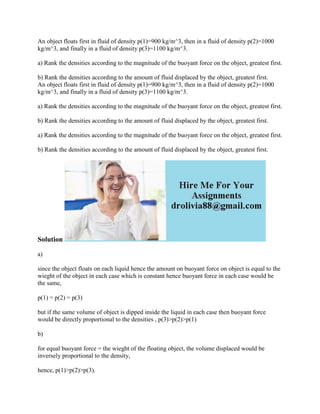Object floats in fluids of varying densities
•Als DOCX, PDF herunterladen•
0 gefällt mir•3 views
The document describes an object floating first in a fluid with a density of 900 kg/m^3, then 1000 kg/m^3, and finally 1100 kg/m^3. It asks to rank the densities by: a) The magnitude of buoyant force on the object, greatest first (1100, 1000, 900 kg/m^3) b) The amount of fluid displaced by the object, greatest first (900, 1000, 1100 kg/m^3) The buoyant force is equal to the weight of the object and depends on density, while the displaced fluid volume inversely depends on density for equal buoyant forces.
Melden
Teilen
Melden
Teilen

Empfohlen
Weitere ähnliche Inhalte
Ähnlich wie Object floats in fluids of varying densities
Ähnlich wie Object floats in fluids of varying densities (10)
Mehr von shawnk7
Mehr von shawnk7 (13)
An IP datagram has arrived with the following information in the heade.docx

An IP datagram has arrived with the following information in the heade.docx
An Institutional Review Board (IRB) is concerned with how human partic.docx

An Institutional Review Board (IRB) is concerned with how human partic.docx
An economy is characterized by the following behavioral equations- C -.docx

An economy is characterized by the following behavioral equations- C -.docx
An auditor examines a sample of cancelled checks to verify that the ch.docx

An auditor examines a sample of cancelled checks to verify that the ch.docx
All of the following are false regarding apportionment except- a Ap.docx

All of the following are false regarding apportionment except- a Ap.docx
Also indicate all zero-force members- Check all that apply- Check all.docx

Also indicate all zero-force members- Check all that apply- Check all.docx
Although objectives- functional tactics- and action items are included.docx

Although objectives- functional tactics- and action items are included.docx
prove or disprove that H - {n e(element) Z- n is divisible by both 8.docx

prove or disprove that H - {n e(element) Z- n is divisible by both 8.docx
Project 3 is based on the materials from Freakonomics Radio Podcast- H.docx

Project 3 is based on the materials from Freakonomics Radio Podcast- H.docx
Problem 9-11A Time Value of Money Concept The following situations inv.docx

Problem 9-11A Time Value of Money Concept The following situations inv.docx
Problem 5- -9 points- A red laser of wavelength 670 nm is directed thr.docx

Problem 5- -9 points- A red laser of wavelength 670 nm is directed thr.docx
Problem 3-32 Internal and Sustainable Growth Rates (LG3-6) Use the fol.docx

Problem 3-32 Internal and Sustainable Growth Rates (LG3-6) Use the fol.docx
Problem 11-6A Problem 11-6A Irwin Corporation has been au.docx

Problem 11-6A Problem 11-6A Irwin Corporation has been au.docx
Kürzlich hochgeladen
Mattingly "AI & Prompt Design: The Basics of Prompt Design"

Mattingly "AI & Prompt Design: The Basics of Prompt Design"National Information Standards Organization (NISO)
Kürzlich hochgeladen (20)
Measures of Central Tendency: Mean, Median and Mode

Measures of Central Tendency: Mean, Median and Mode
Hybridoma Technology ( Production , Purification , and Application ) 

Hybridoma Technology ( Production , Purification , and Application )
Mattingly "AI & Prompt Design: The Basics of Prompt Design"

Mattingly "AI & Prompt Design: The Basics of Prompt Design"
Interactive Powerpoint_How to Master effective communication

Interactive Powerpoint_How to Master effective communication
TataKelola dan KamSiber Kecerdasan Buatan v022.pdf

TataKelola dan KamSiber Kecerdasan Buatan v022.pdf
Call Girls in Dwarka Mor Delhi Contact Us 9654467111

Call Girls in Dwarka Mor Delhi Contact Us 9654467111
Privatization and Disinvestment - Meaning, Objectives, Advantages and Disadva...

Privatization and Disinvestment - Meaning, Objectives, Advantages and Disadva...
Beyond the EU: DORA and NIS 2 Directive's Global Impact

Beyond the EU: DORA and NIS 2 Directive's Global Impact
Object floats in fluids of varying densities
- 1. An object floats first in fluid of density p(1)=900 kg/m^3, then in a fluid of density p(2)=1000 kg/m^3, and finally in a fluid of density p(3)=1100 kg/m^3. a) Rank the densities according to the magnitude of the buoyant force on the object, greatest first. b) Rank the densities according to the amount of fluid displaced by the object, greatest first. An object floats first in fluid of density p(1)=900 kg/m^3, then in a fluid of density p(2)=1000 kg/m^3, and finally in a fluid of density p(3)=1100 kg/m^3. a) Rank the densities according to the magnitude of the buoyant force on the object, greatest first. b) Rank the densities according to the amount of fluid displaced by the object, greatest first. a) Rank the densities according to the magnitude of the buoyant force on the object, greatest first. b) Rank the densities according to the amount of fluid displaced by the object, greatest first. Solution a) since the object floats on each liquid hence the amount on buoyant force on object is equal to the wieght of the object in each case which is constant hence buoyant force in each case would be the same, p(1) = p(2) = p(3) but if the same volume of object is dipped inside the liquid in each case then buoyant force would be directly proportional to the densities , p(3)>p(2)>p(1) b) for equal buoyant force = the wieght of the floating object, the volume displaced would be inversely proportional to the density, hence, p(1)>p(2)>p(3).